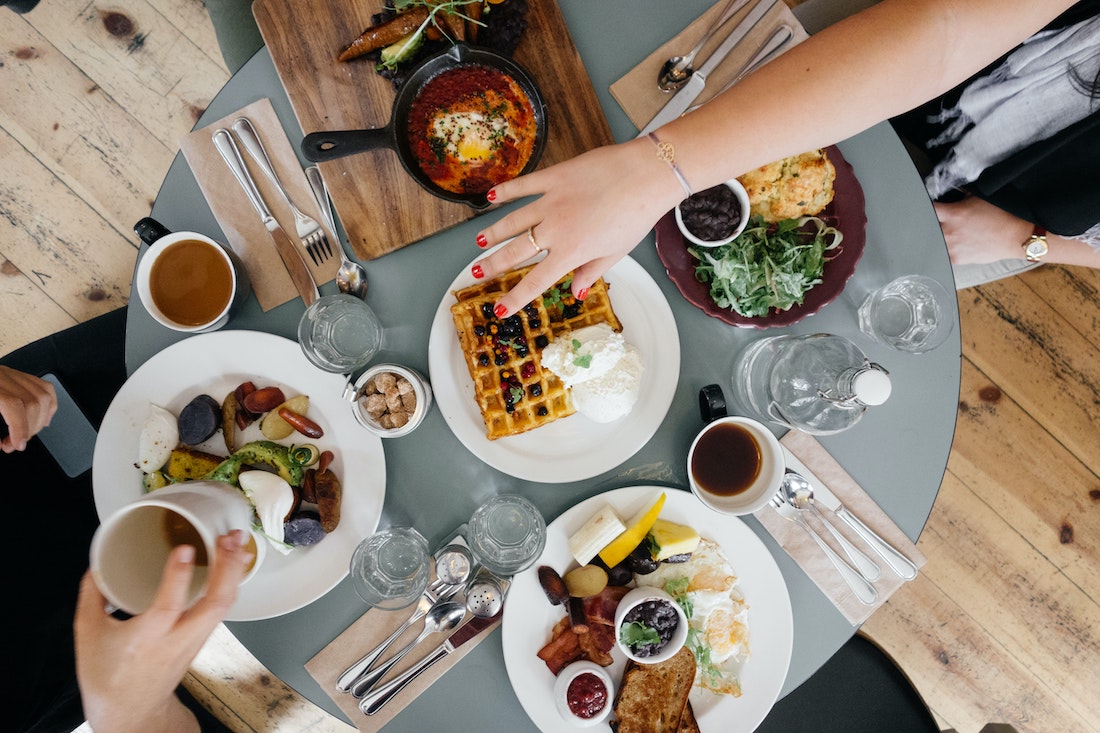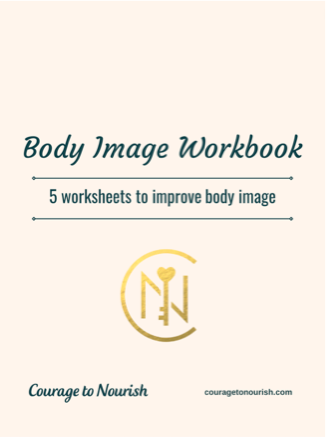What is Intuitive Eating?
Intuitive eating. This phrase gets thrown around a lot, but what does it actually mean?
Just like we were born with the intuition to breathe and sleep, our bodies have the ability to tell us what and how much food they need. This starts from infancy, but can easily be interfered with as we age by factors such as diet culture, emotions, access to food, and more. You can begin your journey back to intuitive eating using the 10 principles developed by its founders, Evelyn Tribole and Elyse Resch.
1. Reject the Diet Mentality
Diet culture is everywhere. It shapes how we eat, move, feel about our bodies, and perceive our health. The first step to intuitive eating is to “toss out” all that you think you know about these things so that you can start with an open mind. Ged rid of your scale, unfollow toxic social media accounts, and delete diet apps. No food or movement rules, no criticizing your body, just you and your intuition. When you have lived in diet culture for your entire life, trusting your body can be scary. But in order to truly become an intuitive eater, this step must be committed to wholeheartedly, otherwise, you will find yourself back to square one. This is often part of the journey – it requires time and patience to heal your relationship with food, but it can be done!
2. Honor Your Hunger
Our body’s job is to tell us what it needs. Our job is to listen and respond.
The body needs to be fed every few hours while awake to function optimally. Waiting too long to eat or trying to suppress your hunger altogether is the best way to find yourself feeling out of control around food. We are built to survive so when our bodies don’t get enough food, they trigger a biological drive that makes us feel hungrier. This can lead to overeating, which diet culture would make us believe is “bad” or “our fault,” when in reality our body is just trying to make sure it gets what it needs.
It should be noted that if you are in eating disorder recovery, you may have to eat in a more structured, mechanical way for a period of time in order to receive reliable hunger cues.
3. Make Peace with Food
Diet culture has told us that there are “good” and “bad” foods. The truth is, all foods fit. No one food is going to make or break your health. The more we forbid ourselves from eating certain foods, the stronger our desire for them becomes. Then when we finally eat these foods, we pack on the guilt and tell ourselves that it’s the last time we’ll do it.
What’s the alternative? Make peace with food by allowing yourself to eat what you are craving. When you satisfy a craving, you end up enjoying food more and thinking about food less. After a while, those foods you once forbid yourself to eat no longer hold an overwhelming power over you. You may still desire them and you can enjoy them – without the guilt!
4. Challenge the Food Police
The food police is the voice in our heads that enforces the food rules we learned from diet culture. It tells us when, what, and how much to eat and grades us based on how well we listen. The food police pulls us away from our intuition. Our bodies know how much energy they require and relay that information to us in the form of hunger and fullness cues. We can start to challenge the food police by talking back. You might say “it’s ok to eat this food,” “my body knows what it needs,” or “I feel better when I nourish my body with foods I enjoy.”
5. Discover the Satisfaction Factor
Eating foods that we like contributes to our happiness and health. Often, after a long period restricting your food, it takes some experimenting to figure out what foods you actually enjoy. During this step of intuitive eating, you get to do just that. Decide what you are craving and prepare your food. Sit down in a relaxing environment so that you can fully focus on your eating experience, undistracted (ditch your phone, computer, and TV). Eat at a mindful pace so that you can really evaluate the taste, texture, aroma, appearance, temperature, and filling-capacity of the food. This may not be your experience every time you eat, but it is helpful when you are re-discovering satisfaction in food.
6. Feel Your Fullness
Part of being an intuitive eater is listening to your body’s experience. When it comes to fullness, it can be physically unpleasant to undereat or overeat. Restricting can put you on a see saw that goes back and forth between the two. When you honor your hunger consistently, it becomes easier to allow yourself to eat to comfortable fullness because you know that if you find yourself hungry again, you can eat! Start by checking in with yourself periodically throughout a meal to gauge your fullness level. You may surpass comfortable fullness sometimes and that’s ok. Every eating experience is a learning opportunity to see what works or does not work for you.
It should be noted that if you are in eating disorder recovery, you may have to eat past fullness to get what your body needs for a period of time in order to receive reliable fullness cues.
7. Cope With Your Emotions With Kindness
Let’s normalize that as humans we turn to food for emotional reasons. Food can provide comfort. But when it’s the only tool in our box of coping skills, it can be problematic because food does not actually address our emotional needs long-term. So if you have determined that your hunger is emotional, rather than physical, pause to ask yourself what you are feeling and what you need. Maybe it’s taking a relaxing bath or chatting with a friend. There are many possibilities so if you feel stuck, it might be helpful to talk to a therapist.
8. Respect Your Body
Similar to our height, our body size is determined by genetics. It is also just as unchangeable. If we try to manipulate our weight, over time, our bodies will fight hard to get back to where they want to be. We have been told by diet culture that we can and should shrink our bodies in the name of health. However, science suggests otherwise and supports a Health At Every Size (HAES) approach. Let’s stop the war on our bodies and show them the respect they deserve.
9. Movement – Feel the Difference
Movement can add to health, but only when we are listening to our bodies. Often times we “should” ourselves into moving. For example, you may tell yourself, I “should” do this type of movement or I “should” do “x” minutes of movement. This is the opposite of intuitive. Instead, ask yourself, “Would it feel good to move?” If the answer is no, that is 100% OK. If the answer is yes, ask yourself, “What type of movement do I enjoy?” and only commit to the amount of movement that your body wants or when you stop having fun.
It should be noted that if you are in eating disorder recovery, you may need to take a break from movement, especially if you have had a disordered relationship with movement in the past.
10. Honor Your Health – Gentle Nutrition
This is the last principle of intuitive eating and for good reason. If you have not mastered the others, it is easy to turn honoring your health with gentle nutrition into another set of food rules. When you start allowing yourself to honor your cravings after being stuck in diet culture for a while, it is likely you will have more of an affinity towards foods that were once forbidden. It takes time to heal our relationship with these foods. Eventually, you might be in a place where you want to expand your variety.
Get Started with Intuitive Eating
Want to learn more? Check out Intuitive Eating: A Revolutionary Program That Works By Evelyn Tribole and Elyse Resch. It is important to note that if you are in eating disorder recovery, we recommend receiving guidance from a dietitian about when and how to introduce intuitive eating. Some principles can be readily incorporated throughout recovery, whereas other principles may only be appropriate during certain stages.
Courage to Nourish is a group of eating disorder specialized dietitians. We have in person locations in Alexandria, Virginia, Columbia, Maryland. and College Park, Maryland. We offer virtual services across the state of Virginia, Washington DC, Pennsylvania, and Colorado. We offer individual nutrition therapy. As well as support groups. We would love to guide you in building a better relationship with food.
Contact us for more information. And to schedule a discovery call. Also, sign up for our client or clinician newsletter!
Take one of our eating disorder quizzes:
- Binge Eating Disorder Quiz
- Anorexia Quiz
- Bulimia Quiz
- ARFID Quiz
- Body Image Quiz
- Disordered Eating Quiz
- Chronic Dieting Quiz
- PCOS Quiz
- Orthorexia Quiz
- Compulsive Exercise Quiz
- RED-S Quiz

As a professional who used to work in a corporate setting, I have seen the negative, daily impact that diet culture has on people’s lives. This led me to discover intuitive eating and Health At Every Size ©, which I now use in working with clients in recovery at the partial hospitalization and intensive outpatient level. I love helping clients find a way of nourishing, moving, and viewing their body that is satisfying and sustainable.
Resources
Intuitive Eating: A Revolutionary Program That Works By Evelyn Tribole and Elyse Resch. 1st Ed.


